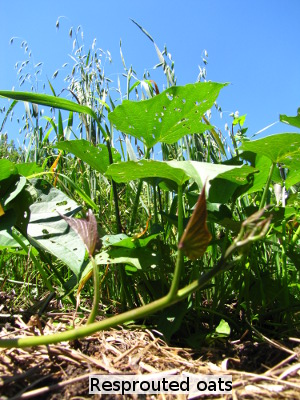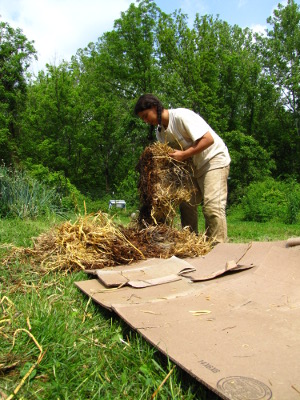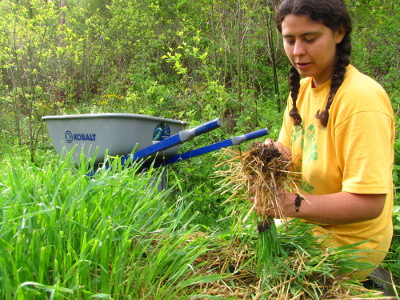
Killing cover crops in a no-till garden
 After deciding
between growing nitrogen
and growing organic matter, the other main factor to
consider when
choosing cover crops for a
no-till garden is—how will you ensure your cover crop doesn't keep
growing as a weed and outcompete your vegetables? While you can
dig
up cover crops or till them in if you're desperate, it's better to
choose crops that are easy to kill without disturbing the ground.
After deciding
between growing nitrogen
and growing organic matter, the other main factor to
consider when
choosing cover crops for a
no-till garden is—how will you ensure your cover crop doesn't keep
growing as a weed and outcompete your vegetables? While you can
dig
up cover crops or till them in if you're desperate, it's better to
choose crops that are easy to kill without disturbing the ground.
In the summer, mowing is
the best way to kill cover crops in a no-till
garden.
Only a few cover crops are easily mow-killed, and even
with those that mow-kill well, you'll want to plan your garden
season so you can allow the crops to reach full bloom (but not set
seed) before cutting them down. Depending on the size of your
garden, you may use a lawnmower or a scythe to do the mowing, or might
simply yank
up handfuls then lay the roots on top of the leaves on a sunny
day. The
latter method is actually my favorite with buckwheat in the summer
garden
since I can often pull up a bed of buckwheat by hand in the same amount
of time it would
take to put the blade on my scythe or to get the gas mower started.
My other favorite method
of killing cover crops in a no-till garden is
to let winter do the work for me. Here's where those of you
gardening
much further north or south than my zone-6 garden will have to do some
experimenting (although Managing
Cover Crops Profitably
does provide zone-related tips on where certain crops will
winter-kill). When I  plant
oilseed radishes and oats in the
fall, cold weather naturally wipes out nearly all the plants during the
winter,
producing a mulch that rots into the soil by early spring (for oilseed
radishes) or by early summer (for oats). Homegrown
Humus
provides planting dates for those of you who want to experiment with
winter-killing.
plant
oilseed radishes and oats in the
fall, cold weather naturally wipes out nearly all the plants during the
winter,
producing a mulch that rots into the soil by early spring (for oilseed
radishes) or by early summer (for oats). Homegrown
Humus
provides planting dates for those of you who want to experiment with
winter-killing.
Although mow-killing and
winter-killing are my favorite ways to kill
cover crops, it's worth having a couple of other techniques up your
sleeve in case your experiments don't go as planned. A kill mulch
is an easy way to kill just about any plants as long as you have a
month or two to wait before planting the next crop. Simply mow
your cover crops as close to the ground as you can, lay down corrugated
cardboard (being sure to overlap the edges by at least four inches so
plants can't sneak up between layers), then top it all off with straw
(or another vegetable-garden-appropriate mulch). Lack of sunlight
will kill all but the most ornery plants in short order, at which point
you can either cut holes in the cardboard to plant directly into the
soil, or can move the cardboard to kill mulch a new garden area.
 If
you don't have time to kill mulch and you really need to get rid of
those cover crops, you'll be forced to pull them up by the roots.
I actually use this method often with buckwheat, which is very simple
to tear out of the soil, but weeding out most other cover crops will be
a lesson in patience. Good planning ensures you won't need to
pull up cover crops by hand very often.
If
you don't have time to kill mulch and you really need to get rid of
those cover crops, you'll be forced to pull them up by the roots.
I actually use this method often with buckwheat, which is very simple
to tear out of the soil, but weeding out most other cover crops will be
a lesson in patience. Good planning ensures you won't need to
pull up cover crops by hand very often.
| This post is part of our Homegrown Humus lunchtime series.
Read all of the entries: |
Want more in-depth information? Browse through our books.
Or explore more posts by date or by subject.
About us: Anna Hess and Mark Hamilton spent over a decade living self-sufficiently in the mountains of Virginia before moving north to start over from scratch in the foothills of Ohio. They've experimented with permaculture, no-till gardening, trailersteading, home-based microbusinesses and much more, writing about their adventures in both blogs and books.
Want to be notified when new comments are posted on this page? Click on the RSS button after you add a comment to subscribe to the comment feed, or simply check the box beside "email replies to me" while writing your comment.
- Remove comment
- Remove comment
